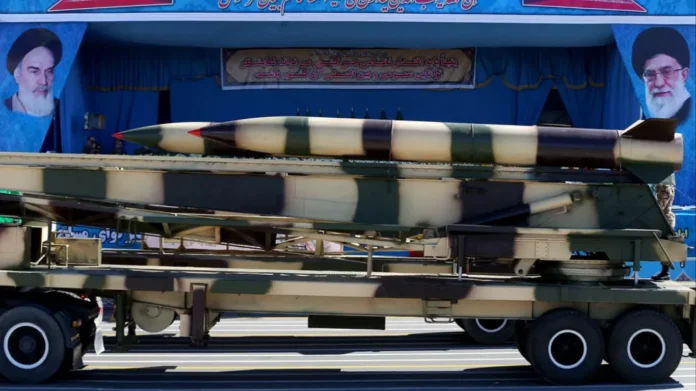On 22 June 2025, Iran’s Islamic Revolutionary Guard Corps (IRGC) displayed its latest long-range solid-fuel ballistic missile, the Kheibar Shekan, during a National Army Day parade in Tehran. The weapon took centre stage in Iran’s 20th wave of missile-drone strikes against Israeli targets, including Ben Gurion Airport and several research sites. Iran calls these raids a “strategic response to Israeli aggression,” and it warned that this attack did not show its full arsenal yet.
Design and Capabilities
The Kheibar Shekan belongs to the fourth generation of the Khorramshahr missile family and boasts a range of 1,450 km, according to Iran’s state news agency IRNA. It uses a solid-fuel engine named “Arond” that fits inside its fuel tank. This integration cuts down on length and helps hide the missile better. When launched from a mobile truck, the missile can be ready in under 15 minutes.
It carries a 1,500 kg high-explosive warhead and measures about four metres in length. Once it leaves the atmosphere, it flies at over 19,500 km/h. As it re-enters, it still travels at nearly 9,800 km/h. These speeds make it very hard for air-defence systems such as Patriot and David’s Sling to stop them.
The missile’s guidance uses satellite data plus small rear engines. It flies in three phases: a boost phase, a midcourse flight, and a terminal phase. In the final phase, it activates its own guidance engines to hit precise targets.
Development History
The Khorramshahr-1 missile appeared in 2017 as Iran’s first attempt at a long-range solid-fuel design. It measured 13 metres long and used a simple warhead. In 2019, Iran unveiled Khorramshahr-2 with guided warheads and a weight of about 20 tonnes. The Khorramshahr-4 came in May 2023, but Iran never shared details on the third version, Khorramshahr-3. Military sources outside Iran confirm Khorramshahr-3 has advanced features, but they remain classified for security reasons.
Symbolic Significance
Iran named the missile “Kheibar Shekan,” which means “Breaker of Khyber.” The name links back to an early Islamic battle in Arabia where Imam Ali bin Abi Talib led an army against a Jewish fortress at Khyber. This historic tie gives the weapon deep meaning among Shiite communities and underlines Iran’s view of its conflict with Israel as not just military but also ideological.
Recent Deployment
Western media, including Reuters, reported that Iran first used the Kheibar Shekan in its “Sadiq Promise 1” attacks in April 2024 and again in “Sadiq Promise 2” strikes in October 2024 . Iran’s increasing reliance on this model shows it trusts the missile for precise, long-range missions. Each launch sends a strong signal that Iran can strike far-reaching targets with weapons it links to its religious roots.
Short Analysis
The Kheibar Shekan missile reflects Iran’s push to blend modern military power with deep-rooted religious symbolism. Its speed and accuracy challenge even top defence systems. By tying its name to a historic battle, Iran sends a message that its actions come from faith as much as from strategy. Observers should watch for more tests and potential sales to allies. If Iran keeps improving its guidance systems, this missile could shift calculations across the Middle East and beyond.
Sources: Euro News

